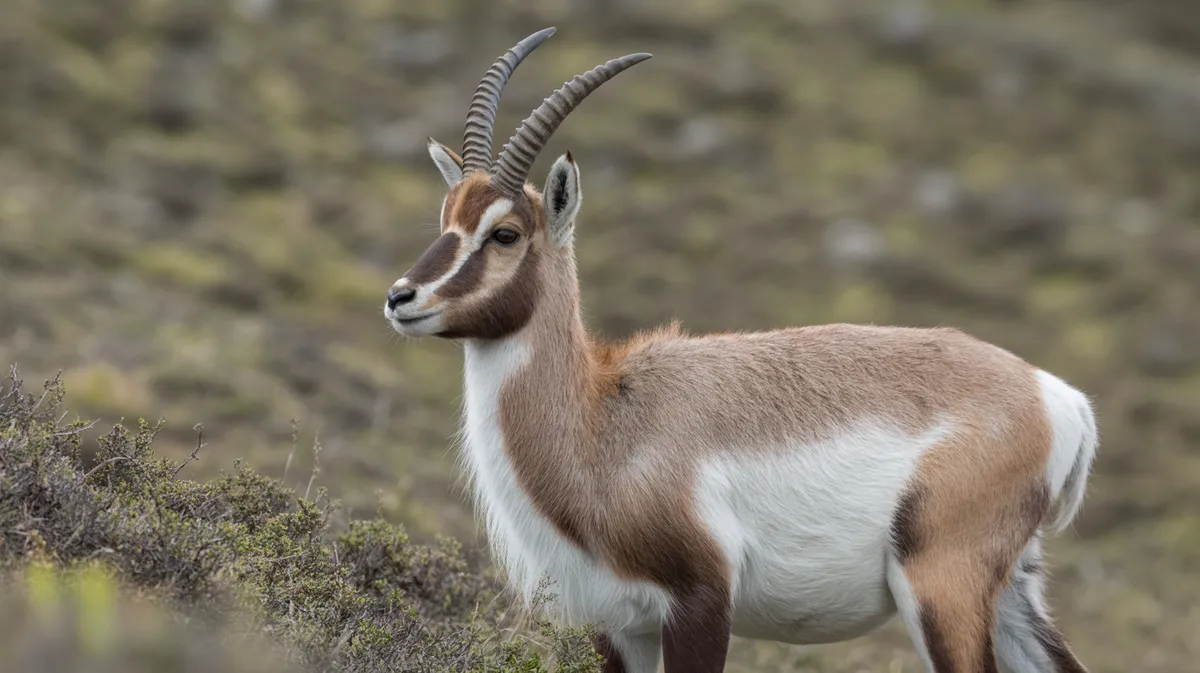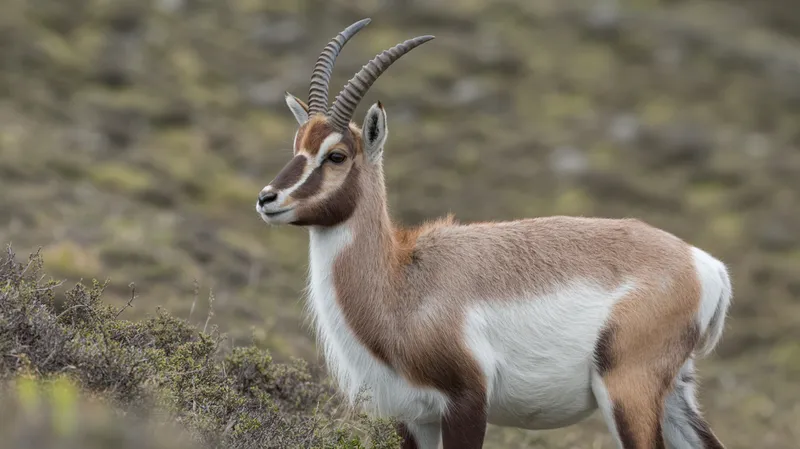
Tibetan Antelope
Pantholops hodgsonii

Meet the Tibetan Antelope
The Tibetan Antelope, also known as the chiru, is a medium-sized antelope native to the high-altitude plains and plateaus of the Tibetan region. Adapted to the harsh, cold climates, this species possesses a dense, fine undercoat called shahtoosh, which unfortunately makes it a target for poaching. Males are distinguished by slender, backward-curving horns, while females lack horns or have very short ones. Tibetan antelopes are social animals, often forming large herds, and are well-known for their impressive migratory journeys across the plateau.
Classification
Mammal
Habitat
High-altitude alpine steppe and plateau
Diet
Herbivore
Lifespan
8-12 years
Conservation
Near Threatened
Weight
18–40 kg
📖Fascinating Facts
Extreme Altitude Adaptation
Tibetan antelopes live at some of the highest elevations of any large mammal, often above 5,000 meters where oxygen levels are extremely low.
Unique Wool
Their underfur, called shahtoosh, is exceptionally fine and warm, making it highly sought after for luxury shawls.
Long-Distance Migration
Females travel up to 300 km each year to reach traditional calving grounds, making one of the highest-altitude mammalian migrations in the world.
📋Detailed Description
The Tibetan antelope (Pantholops hodgsonii), or chiru, is a medium-sized bovid uniquely adapted to the extreme environments of the Tibetan Plateau, typically inhabiting elevations between 3,700 and 5,500 meters. Adult males stand about 83–85 cm at the shoulder and weigh 39–45 kg, while females are slightly smaller. Males are easily recognized by their long, slender, black horns, which can reach up to 60 cm in length, whereas females usually lack horns or possess very short ones. The species is characterized by a dense, pale brown to grayish coat, with a distinctive white underbelly and rump patch. The underfur, known as shahtoosh, is exceptionally fine and provides insulation against subzero temperatures. Tibetan antelopes are highly gregarious, forming large migratory herds that can number in the hundreds or thousands, especially during the summer. Their large, wide-set nostrils and specialized hemoglobin facilitate efficient oxygen uptake in hypoxic high-altitude environments. The species is primarily diurnal, with peak activity in the early morning and late afternoon. Their keen eyesight and agility allow them to detect and evade predators such as wolves and snow leopards. The chiru plays a significant ecological role as a grazer, influencing alpine steppe vegetation dynamics.
💡 Did you know?
The shahtoosh wool of the Tibetan antelope is so valued that illegal poaching for this material brought the species to the brink of extinction in the 20th century.
🔬Research & Sources
Wikipedia Summary
The Tibetan antelope or chiru is a medium-sized bovid native to the northeastern Tibetan plateau. Most of the population live within the Chinese border, while some scatter across India and Bhutan in the high altitude plains, hill plateau and montane valley. Fewer than 150,000 mature individuals are left in the wild, but the population is currently thought to be increasing.
Last Modified: 5/18/2025
🎭Behavior & Social Structure
Tibetan antelopes exhibit pronounced seasonal migrations, with females traveling up to 300 km to traditional calving grounds in late spring and returning with their young in late summer. Herds are generally segregated by sex outside the breeding season, with males forming bachelor groups and females and juveniles forming larger herds. Feeding primarily on alpine grasses, sedges, and forbs, chiru graze throughout the day, with foraging interspersed with periods of vigilance and rest. They are highly alert, using visual and auditory cues to detect predators, and can reach running speeds of up to 80 km/h when threatened. Social interactions include mutual grooming and synchronized movements during migration. During the rut, males become territorial and may engage in displays or sparring to establish dominance and access to females.
👶Reproduction & Life Cycle
The breeding season (rut) occurs from November to December, during which dominant males establish temporary territories and compete for access to groups of females. Mating is polygynous, with a single male often guarding a harem of several females. Gestation lasts approximately 6 months, with most births occurring in June or July. Females typically give birth to a single calf, which is able to stand and follow its mother within hours. Calves are hidden in vegetation for the first few days to avoid predation. Maternal care is pronounced, with mothers nursing and protecting their young until they are strong enough to join the migrating herd. Sexual maturity is reached at 2–3 years for females and 3–4 years for males.
🛡️Adaptations & Survival
Tibetan antelopes possess several remarkable adaptations for high-altitude survival. Their dense, ultra-fine underfur (shahtoosh) provides exceptional thermal insulation. Enlarged nasal cavities and a high concentration of red blood cells enhance oxygen uptake in thin air. Their limbs are long and slender, facilitating efficient long-distance travel and rapid escape from predators. Behavioral adaptations include synchronized migrations to optimize access to food and safe calving sites, as well as group vigilance to reduce predation risk. Their digestive system is specialized for extracting nutrients from sparse, fibrous alpine vegetation.
📚Research Sources
🎨Cultural Significance
The chiru holds symbolic value in Tibetan culture, representing endurance and purity. Its shahtoosh wool was historically prized by royalty and elites in South Asia, contributing to its decline. The species is featured in local folklore and is considered a flagship species for the conservation of the Tibetan Plateau. International campaigns to ban shahtoosh trade have raised global awareness of the chiru's plight.
🔬Recent Research & Discoveries
Recent genetic studies have clarified the evolutionary relationships of Pantholops, placing it as a unique lineage within the Bovidae, distinct from true antelopes and more closely related to goats and sheep. Ongoing research focuses on the impacts of climate change and infrastructure on migration routes, with GPS collaring projects revealing precise migratory corridors. Studies on the physiological adaptations of chiru to hypoxia have contributed to broader understanding of mammalian high-altitude adaptation. Conservation genetics is being used to monitor population structure and genetic diversity, informing management strategies.
🎥Wildlife Videos

FULL EPISODE: One of the World's Most Remote Places: The Tibetan Plateau | Wild China | BBC Earth
The far-reaching Tibetan plateau is one of the world's most remote places. It's home to chiru antelopes, wild yaks, foxes and bears ...
BBC Earth

The Adventures of a Tibetan Antelope | #Preview
On the grassland of Qiangtang, what does the young Tibetan antelope have to go through to become the king?
Amazing Kylin

Mysteries of the Mountains - Exploring Tibet's Wildlife | Full Documentary
Tibet's Animal Kingdom is an exploration of a wildlife kingdom flanked by the mighty Himalayas. From lush alpine valleys to snowy ...
Free High-Quality Documentaries

The Adventures of a Tibetan Antelope|#01 - Escaping from a wolf's mouth
Is it possible for a newborn antelope to escape from a wolf's mouth? Unbelievable but not impossible, as baby Tibetan antelope ...
Amazing Kylin

Thin-air marathoners: How Tibetan antelopes thrive in harsh nature
Each migration season, thousands of Tibetan antelopes surge through the snowy mountains like a living river -- fluid, powerful, ...
New China TV

The Adventures of a Tibetan Antelope|#02 - Tangjie's Home Tour
Follow Tangjie's migration for a tour of the beautiful Qiangtang grassland!
Amazing Kylin
🌍Habitat Information
The Tibetan Antelope typically inhabits High-altitude alpine steppe and plateau environments. Tibetan Antelopes have adapted to their environments with specialized features and behaviors.
Primary Habitat:
High-altitude alpine steppe and plateau
More detailed habitat information will be available soon.
🛡️Conservation Status
The Tibetan Antelope is currently classified as Near Threatened. Conservation efforts are crucial for preserving this species for future generations.
Common Threats:
- 🏠Habitat loss and fragmentation
- 🌡️Climate change impacts
- 🎯Hunting and poaching
- 🏭Human-wildlife conflict
⚠️Threats & Conservation Challenges
The primary threat to Tibetan antelopes has been poaching for shahtoosh wool, which is illegally used to make luxury shawls. Habitat fragmentation due to infrastructure development, such as roads and railways (notably the Qinghai-Tibet Railway), poses barriers to migration and increases mortality risk. Climate change may alter alpine steppe ecosystems, affecting food availability. Despite legal protections and increased anti-poaching efforts, illegal hunting persists in some areas. The population, once reduced to fewer than 75,000 individuals in the 1990s, has partially recovered due to conservation measures but remains vulnerable, with current estimates of mature individuals ranging from 100,000 to 150,000.
🔬Scientific Classification
Scientific Name
Pantholops hodgsonii
Classification Hierarchy
🔍 About Taxonomic Classification
Taxonomic classification is a hierarchical system used by scientists to classify and organize living organisms based on shared characteristics and evolutionary relationships.
The system moves from broad categories (Kingdom) to increasingly specific ones, with each animal's scientific name typically consisting of its Genus and species.
📝Community Notes
Share your observations and insights about the Tibetan Antelope with our community of wildlife enthusiasts.
Join Our Community
Sign in to share your observations and connect with fellow wildlife enthusiasts.
Sign In to ContributeNo community notes yet
Be the first to share your observations about the Tibetan Antelope!
Explore Tibetan Antelope
Select a tab above to learn more about this amazing animal.
📸Photo Gallery
No photos available for this animal yet.
🌟Discover More Wildlife
Continue your journey of discovery with more fascinating animals from our database
